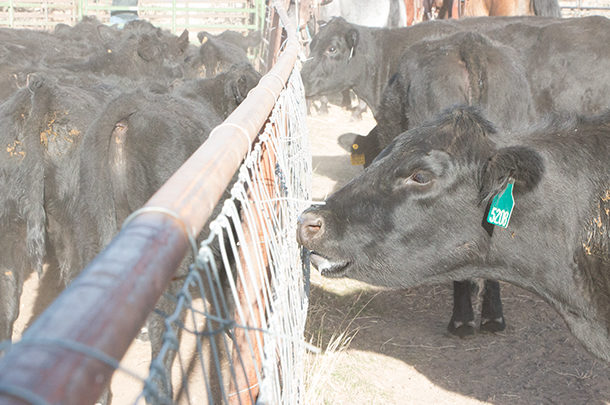Cattle producers are surrounded by data. Whether it’s weaning weights, days open or number of cattle on a given pasture, the data we collect on our operations is only beneficial if we utilize it.
As a beef cattle nutritionist, I get a lot of questions about records, why data insights are important and how producers can use the data they’re already collecting to make more informed business and management decisions. Here are some of the most common questions I’ve received over the years and my recommendations when discussing data collection and usage with producers.
What kinds of records do you see producers keeping and why are they important?
Some of the main records I see on cattle operations include conception rates, live birth rates, weaning weights, feed expenditures and body condition scoring. All of these records are tied to profitability. You can’t manage what you don’t measure, so you need the hard data from these records to be more accurate and scientific when making management decisions for your herd. When we manage our herd based on the insights we can gather from our records and what we are seeing in our fields, we are better able to get a holistic picture of what’s really going on.
It gives us more flexibility with our decisions and allows us to increase our confidence in the decisions we do make. For example, if we are tracking conception rates, live birth rates and weaning weights, we can better understand how a cow is performing. This historical view can help us determine whether we should cull the animal due to sustained reproductive failure versus feeling like we have to cull an animal because the herd has grown too large and her most recent performance was poor.
Are there any additional records I should consider keeping?
Whether or not your operation needs more records depends on what your goals are. Additionally, different types of operations may require different types of records. If you only raise show calves, you will need different records than someone who manages seedstock or a commercial herd. Generally speaking, there is always room for improvement with recordkeeping, so I like to recommend you at least have the records listed above and make sure you’re doing a good job tracking the information for each.
If you think you might need more records or your current records might have gaps, reach out to your veterinarian, nutritionist or a trusted friend to get some additional eyes on what you’re currently doing. In certain instances, producers might be keeping too many or the wrong kinds of records. We want to optimize the time spent on this task to give us the best return.
How do I take the information in records and translate it into actionable decisions in my operation?
It depends on whether you are using the data to address a specific problem or if you are looking to improve what you are doing overall. If you are addressing a particular problem, what do your records say? Is there a recurring pattern of issues in a group of cattle on a specific field? Are there other external factors like excessive heat that could be impacting your herd? Were there any changes to feed or vaccination schedules in the past twelve months?
When we have solid records, we can look back on the past year and identify factors that may be negatively impacting herd performance. Good recordkeeping is part of the proverbial journey, not the destination. It is not something you do once and forget about. Instead, it is a key part of the management of your operation and its improvement.
Conversely, if you are looking to improve your herd, the first question to ask yourself is where do you think there is room for improvement? Are you seeking to increase weaning weights by a certain amount? Are you looking for an increase in live birth rates? Once you identify the areas you want to improve, then you can start looking at the records associated with them and developing an action plan based on previous performance and current conditions.
Are there any limitations to relying on records for herd insights?
Regardless of whether you are looking at your short-term or long-term goals, it’s vital you get a complete view of your entire operation and not rely exclusively on records. Records can help prevent big blows to an operation; however, everything measured is a lagging indicator, meaning changes made may not have immediate or visible impact in the short term. It could be nine to 12 months before you see an impact on herd performance.
Another important thing to note is that correlation does not equal causation. As humans, we are very good at pattern recognition, but we have to be careful not to fall into false pattern recognition. For example, say you get a new bull and conception rates are up 5%. This is great news for your herd, so it must be attributed to the new bull! In reality, that may not be the case. It could be the 5-plus inches of rain you received. Or perhaps you changed mineral sources and your herd is now receiving a better quality mineral. While records are an extremely valuable tool, they will not replace walking the pastures, providing quality nutrients, maintaining veterinary care and other essential best management practices.
I am new or unfamiliar with recordkeeping, where should I start?
The first step I would recommend is taking a look at what you currently have available to you. Do you keep any records related to weight or financials? A monthly body condition score, weaning weights, conception rates and feed expenditures are good records to begin with for someone just getting started. Determine a process that works for you to record information and keep data together.
Are there any tools or resources I may consider using to help with data collection, storage or management?
Data management tools can be as complicated or simple as you want; it is all about finding the best fit for your operation. Written notebooks, spreadsheets and specialized software are three common types of management tools. Regardless of your choice, keeping quality records is vital. If you currently keep records and then do not use the information you capture, it defeats the purpose of the records in the first place, and your time is better spent elsewhere.
What other recommendations do you have for producers making business and management decisions based on data insights?
One of the key success factors I would recommend to every cattleman and cattlewoman would be to have someone else take a look at your operation who can give you a fresh set of eyes. Talk to this person about your goals and how you would like to reach them. It could be your veterinarian, nutritionist, a trusted friend or mentor. Remember, even John Wayne asked for help sometimes! Being open and honest about your operation and management practices is an essential step in getting on the path to your goals.
An easy way to think about it is to break it down into three questions: what should you do, what can you do and what will you actually do. There will always be a low-hanging fruit on every operation, but there is also room for incremental improvement. Once you have these questions answered and your goals outlined, you can start putting together a plan to get there.
Catch a new Progressive Cattle podcast with Dusty Abney that busts some nutritional myths for your herd. Listen to the Progressive Cattle podcast on your favorite platform or at Progressive Cattle podcast.









